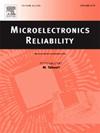纳米cu烧结接头在时效过程中的微观组织和扩散机制:接头尺寸、孔隙率和时效气氛的影响
IF 1.9
4区 工程技术
Q3 ENGINEERING, ELECTRICAL & ELECTRONIC
引用次数: 0
摘要
与纳米银/金相比,纳米铜的烧结键合成本较低,在电力电子和集成电路的模具键合中受到广泛关注。然而,具有纳米孔微观结构的烧结铜接头的氧化仍然是影响其可靠性的一个问题。本研究系统地研究了接头尺寸、孔隙率和时效气氛对烧结铜氧化机理的影响。在高温环境时效过程中,低孔隙率(4.27%)Cu凸起(直径60 μm)中首次观察到异常的孔洞生长,而在大面积烧结Cu (3 × 3 mm2)中没有观察到异常的孔洞生长。提出了一种基于氧化驱动扩散的假设。结果表明,微尺度的凹凸尺寸导致纳米孔Cu与Cu2O表面氧化物之间存在较大的化学势梯度,导致大量Cu原子通过晶界扩散。真空时效表现为凸点中心的奥斯特瓦尔德熟化,凸点边缘的空位向凸点外扩散,与环境时效完全不同。对于高孔隙率(17.12%)的Cu包块,O2通过连接的孔洞渗透,直接在孔洞内部形成氧化物。研究结果揭示了微尺度烧结铜互连中的氧化机制,这对于集成电路和电力电子的先进封装至关重要。本文章由计算机程序翻译,如有差异,请以英文原文为准。

Microstructure and diffusion mechanisms in nano-Cu sintered joints during aging: Effects of joint size, porosity, and aging atmosphere
Sintering bonding by nano-Cu is receiving great interests in die bonding of both power electronics and integrated circuits (IC) due to its low cost compared with nano-Ag/Au. However, oxidation of sintered Cu joints, having nanoporous microstructure, remains a concern for the reliability. This study systematically studied the effects of joint size, porosity, and aging atmosphere on the oxidation mechanisms of sintered Cu. An abnormal void growth was observed for the first time in low-porosity (4.27 %) Cu bumps (60 μm diameter) during high-temperature ambient aging, which was not observed in large-area sintered Cu (3 × 3 mm2). A hypothesis was proposed based on diffusion driven by oxidization. It indicated that the microscale bump size caused high chemical potential gradient between the nanoporous Cu and the Cu2O surface oxide, leading to a massive Cu atom diffusion through grain boundaries. Vacuum aging showed Ostwald ripening in bump center and vacancies in bump edge diffusing out of bumps, which was totally different from ambient condition. For high-porosity (17.12 %) Cu bumps, oxide was directly formed inside voids due to the penetration of O2 through the connected voids. The findings revealed the oxidation mechanisms in microscale sintered Cu interconnects, which was essential for the advanced packaging of both IC and power electronics.
求助全文
通过发布文献求助,成功后即可免费获取论文全文。
去求助
来源期刊

Microelectronics Reliability
工程技术-工程:电子与电气
CiteScore
3.30
自引率
12.50%
发文量
342
审稿时长
68 days
期刊介绍:
Microelectronics Reliability, is dedicated to disseminating the latest research results and related information on the reliability of microelectronic devices, circuits and systems, from materials, process and manufacturing, to design, testing and operation. The coverage of the journal includes the following topics: measurement, understanding and analysis; evaluation and prediction; modelling and simulation; methodologies and mitigation. Papers which combine reliability with other important areas of microelectronics engineering, such as design, fabrication, integration, testing, and field operation will also be welcome, and practical papers reporting case studies in the field and specific application domains are particularly encouraged.
Most accepted papers will be published as Research Papers, describing significant advances and completed work. Papers reviewing important developing topics of general interest may be accepted for publication as Review Papers. Urgent communications of a more preliminary nature and short reports on completed practical work of current interest may be considered for publication as Research Notes. All contributions are subject to peer review by leading experts in the field.
 求助内容:
求助内容: 应助结果提醒方式:
应助结果提醒方式:


